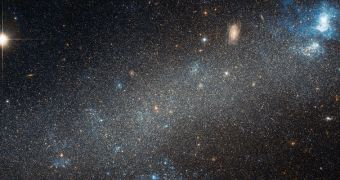While conducting a detailed analysis of the dwarf galaxy NGC 2366, a team of astronomers operating the NASA/ESA Hubble Space Telescope has discovered that the formation is home to a bright, relatively large stellar nursery. The object is so close that experts can make out its individual components.
A stellar nursery is a region of space that concentrates important amounts of hydrogen gas and cosmic dust, both of which are critically important ingredients for the formation of new stars. When conditions are right, portions of these clouds collapse, leading to the formation of protostars.
These structures are common throughout the Universe, but exist in varied sizes in different galaxies. NGC 2366 is not particularly large, and does not even feature spiral arms. In fact, astronomers classify it as a dwarf galaxy. However, this does not stop it from forming new stars.
Nurseries produce protostars at different rates, depending on external influences – such as supernova blasts taking place nearby – and internal factors; for example, the density and concentration of available gas. Our Sun was born into such a structure as well.
The image to the left shows the central regions of NGC 2366, astronomers say. The nebula Hubble identified is the bright-blue region on the upper right. The orange structure a bit to the left is in fact a very distant, very large spiral galaxy that is in no way attached to the nebula.
Despite their size, galaxies are mostly made up of empty space, so light from objects located behind them (as seen from our point of reference) can theoretically pass through. If stars interact with each other loosely, then background objects can be seen even clearer.
Statistically speaking, NGC 2366 is in the same league as the Small and Large Magellanic Clouds, in terms of size. The two are dwarf galaxies that orbit the much-larger Milky Way. The latter has a diameter of around 100,000 light-years, Science Daily reports.
The dwarf galaxy is also cataloged as an irregular object, since it lacks any type of defined boundaries. It is located no more than 10 million light-years away, towards the constellation of Camelopardalis.
Due to the fact that its star supplies are constantly replenished, NGC 2366 is currently home to some pretty impressive stellar objects, including blue giants. These are among the most massive, brightest stars in the Universe.
As a general rule, these objects sacrifice a long lifespan, of ten billion years or more, in order to live just a few hundred million years, and explode in massive supernova blasts afterwards. They will most likely become either neutron stars or black holes afterwards.

 14 DAY TRIAL //
14 DAY TRIAL //